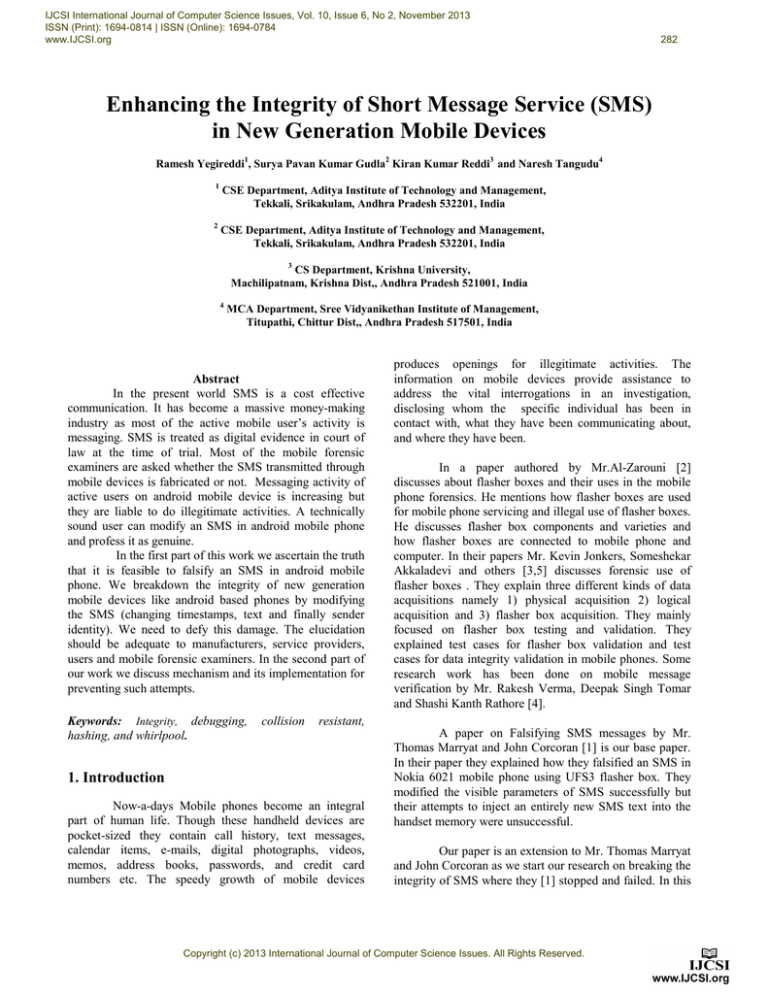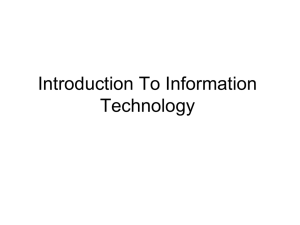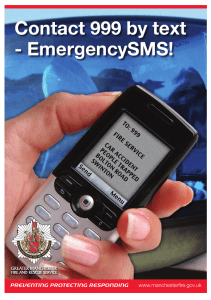
IJCSI International Journal of Computer Science Issues, Vol. 10, Issue 6, No 2, November 2013
ISSN (Print): 1694-0814 | ISSN (Online): 1694-0784
www.IJCSI.org
282
Enhancing the Integrity of Short Message Service (SMS)
in New Generation Mobile Devices
Ramesh Yegireddi1, Surya Pavan Kumar Gudla2 Kiran Kumar Reddi3 and Naresh Tangudu4
1
CSE Department, Aditya Institute of Technology and Management,
Tekkali, Srikakulam, Andhra Pradesh 532201, India
2
CSE Department, Aditya Institute of Technology and Management,
Tekkali, Srikakulam, Andhra Pradesh 532201, India
3
CS Department, Krishna University,
Machilipatnam, Krishna Dist,, Andhra Pradesh 521001, India
4
MCA Department, Sree Vidyanikethan Institute of Management,
Titupathi, Chittur Dist,, Andhra Pradesh 517501, India
Abstract
In the present world SMS is a cost effective
communication. It has become a massive money-making
industry as most of the active mobile user’s activity is
messaging. SMS is treated as digital evidence in court of
law at the time of trial. Most of the mobile forensic
examiners are asked whether the SMS transmitted through
mobile devices is fabricated or not. Messaging activity of
active users on android mobile device is increasing but
they are liable to do illegitimate activities. A technically
sound user can modify an SMS in android mobile phone
and profess it as genuine.
In the first part of this work we ascertain the truth
that it is feasible to falsify an SMS in android mobile
phone. We breakdown the integrity of new generation
mobile devices like android based phones by modifying
the SMS (changing timestamps, text and finally sender
identity). We need to defy this damage. The elucidation
should be adequate to manufacturers, service providers,
users and mobile forensic examiners. In the second part of
our work we discuss mechanism and its implementation for
preventing such attempts.
Keywords: Integrity, debugging,
hashing, and whirlpool.
collision
produces openings for illegitimate activities. The
information on mobile devices provide assistance to
address the vital interrogations in an investigation,
disclosing whom the specific individual has been in
contact with, what they have been communicating about,
and where they have been.
In a paper authored by Mr.Al-Zarouni [2]
discusses about flasher boxes and their uses in the mobile
phone forensics. He mentions how flasher boxes are used
for mobile phone servicing and illegal use of flasher boxes.
He discusses flasher box components and varieties and
how flasher boxes are connected to mobile phone and
computer. In their papers Mr. Kevin Jonkers, Someshekar
Akkaladevi and others [3,5] discusses forensic use of
flasher boxes . They explain three different kinds of data
acquisitions namely 1) physical acquisition 2) logical
acquisition and 3) flasher box acquisition. They mainly
focused on flasher box testing and validation. They
explained test cases for flasher box validation and test
cases for data integrity validation in mobile phones. Some
research work has been done on mobile message
verification by Mr. Rakesh Verma, Deepak Singh Tomar
and Shashi Kanth Rathore [4].
resistant,
1. Introduction
Now-a-days Mobile phones become an integral
part of human life. Though these handheld devices are
pocket-sized they contain call history, text messages,
calendar items, e-mails, digital photographs, videos,
memos, address books, passwords, and credit card
numbers etc. The speedy growth of mobile devices
A paper on Falsifying SMS messages by Mr.
Thomas Marryat and John Corcoran [1] is our base paper.
In their paper they explained how they falsified an SMS in
Nokia 6021 mobile phone using UFS3 flasher box. They
modified the visible parameters of SMS successfully but
their attempts to inject an entirely new SMS text into the
handset memory were unsuccessful.
Our paper is an extension to Mr. Thomas Marryat
and John Corcoran as we start our research on breaking the
integrity of SMS where they [1] stopped and failed. In this
Copyright (c) 2013 International Journal of Computer Science Issues. All Rights Reserved.
IJCSI International Journal of Computer Science Issues, Vol. 10, Issue 6, No 2, November 2013
ISSN (Print): 1694-0814 | ISSN (Online): 1694-0784
www.IJCSI.org
283
paper we break the integrity of SAMSUNG i9300 (Galaxy
S3) android mobile device by modify the SMS visible
parameters and even text without using any flasher box.
The Organization of paper as in the section-3
choosing right cable and USB Debugging on mobile
device, section-4 Altering SMS visible parameters and we
discuss about modifying SMS text in SAMSUNG i9300
(Galaxy S3). Finally we discuss the counter mechanism for
these illegitimate activities.
2. Breaking
Integrity
Fig 2 Eenabling USB debugging option in SAMSUNG i9300
2.1 Choosing Right Cable Connector
First we should connect the mobile to computer
with help of suitable connector. The connector depends on
type of mobile. As the first step to our experiment we
connect the SAMSUNG i9300 (Galaxy S3) to the
computer. Fig. 1 shows the connection between mobile
device and computer.
Table 1 shows the USB Debugging option in
different android mobiles like Micromax, Sony Xperia and
SAMSUNG.
Table 1 USB debugging options in Different Mobiles.
Mobile Type
Micromax
Sony Xperia,
SAMSUNG
i9300
(Galaxy
S3)
Path
Settings Developer Options
USB Debugging
Settings Application
development
USB
Debugging
Table 2 shows the path to enable the USB
debugging in different android version like 2.0, 3.0, 4.0
and 4.2
Table 2 USB debugging options in different android versions
Fig. 1 Connecting Mobile Device to Computer
Version
Android 2.0
2.2 Enable USB Debugging in Mobile Device
Android 3.0
To import the contents of the mobile to a PC, the
PC must be installed with suitable software which enables
the PC to be connected with the mobile. After connecting
the targeted android mobile device (Samsung i9300 galaxy
s3) to a PC, we need to dig out contents from the android
mobile device. To dig out the content from Mobile device,
we should enable USB debugging option in corresponding
mobile. Fig. 2 shows series of steps user has to go through
to enable USB debugging option in SAMSUNG i9300
(Galaxy S3).
Android 4.0
Android 4.2
Path
Settings
Applications
Development USB Debugging
Settings
Applications
Debugging USB debugging
Menu Settings Developer
options USB Debugging
Settings About Phone Build
Number Tap on it 7 Times
Developer option USB debugging
3 Modify SMS visible parameters
Copyright (c) 2013 International Journal of Computer Science Issues. All Rights Reserved.
IJCSI International Journal of Computer Science Issues, Vol. 10, Issue 6, No 2, November 2013
ISSN (Print): 1694-0814 | ISSN (Online): 1694-0784
www.IJCSI.org
Once connection is established all the contents
(call history, text messages, e-mails, digital photographs,
videos, calendar items, memos, address books, passwords,
and credit card numbers etc) of mobile are extracted to the
computer. Fig 3 and Fig 4 shows the contents of
SAMSUNG i9300 (Galaxy S3), extracted to the computer.
284
Code after Modification of timestamp
<sms>
<Id>0</Id>
<Numbers>+919490346746</Numbers>
<Body>Send me Rs 25000/-.</Body>
<SmsType>0</SmsType>
<Time>2013-07-17T11:44:55.608+05:30</Time>
<ThreadId>679</ThreadId>
<Status>2</Status>
<ChatType>0</ChatType>
</sms>
Fig 3 Contents of SAMSUNG i9300 (Galaxy S3)
Fig 5 SMS Time Stamp modification before and after
Fig 4 Inbox of SAMSUNG i9300 (Galaxy S3)
3.1 Altering SMS text
Most android based mobiles store messages in
SQLite database. These messages are transmitted and
stored in xml format. First, extract wanted SMS then save
it on computer. This SMS will be saved in .xml format.
Now open the file, change the required visible parameters
of SMS then save it. Now delete original SMS in mobile
then export modified xml file into mobile. Figure 4.3
shows the SMS before modification and after modification
in circles which is part of xml format.
Code Before modification of timestamp
<sms>
<Id>0</Id>
<Numbers>+919490346746</Numbers>
<Body>Send me Rs 25000/-.</Body>
<SmsType>0</SmsType>
<Time>2013-07-17T10:46:35.608+05:30</Time>
<ThreadId>679</ThreadId>
<Status>2</Status>
<ChatType>0</ChatType>
</sms>
The process of altering SMS text is done as we
did in altering SMS visible parameters. This SMS shall be
saved in .xml format. Now open the file, change the
required text of SMS then save it. Now delete original
SMS in mobile and export the modified xml file into
mobile.
Code Before modification of text
<Sms>
<Id>0</Id>
<Numbers>+919490346746</Numbers>
<Body>Send me Rs 25000/-.</Body>
<SmsType>0</SmsType>
<Time>2013-07-17T10:46:35.608+05:30</Time>
<ThreadId>679</ThreadId>
<Status>2</Status>
<ChatType>0</ChatType>
</Sms>
Code after modification of text
Copyright (c) 2013 International Journal of Computer Science Issues. All Rights Reserved.
IJCSI International Journal of Computer Science Issues, Vol. 10, Issue 6, No 2, November 2013
ISSN (Print): 1694-0814 | ISSN (Online): 1694-0784
www.IJCSI.org
<Sms>
<Id>0</Id>
<Numbers>+919490346746</Numbers>
<Body>Send me Rs 225000/-.</Body>
<SmsType>0</SmsType>
<Time>2013-07-17T10:46:35.608+05:30</Time>
<ThreadId>679</ThreadId>
<Status>2</Status>
<ChatType>0</ChatType>
</Sms>
Fig 6 SMS Text modification before and after
Fig 7 shows the modification of SMS text and sender
number in computer.
285
forensic examination. In my opinion, to provide integrity
for an SMS Hashing method is preferable. In the section of
this paper we propose a 512 bit collision resistance hash
function Whirlpool [6, 7] through which simply SMS can
then be hashed.
4.2 Whirlpool hash Function
Whirlpool is an iterated cryptographic hash
function, based on the Miyaguchi-Preneel scheme [8, 9,
10, 11], that uses a symmetric-key block cipher in place of
the compression function. Whirlpool is a collision-resistant
512-bit hash function designed by Baretto and Rijmen and
operates on messages less than 2256 bits in length.
Whirlpool is based on an underlying dedicated block
cipher W, with the block length of 512-bit. The block
cipher W employs a SPN type round function. It is claimed
that the diffusion layer of W uses an 8*8 matrix with the
branch number β = 9. Due to the Square pattern
propagation theorem, it is guaranteed that the number of Sboxes with a different input value in four consecutive
rounds is at least β2 = 81.
By combining S-boxes with the maximum
differential probability equal to 2-5, it was shown that no
differential characteristic over four rounds of W has
probability larger than (2-5)81 = 2-405. Accordingly, it is
estimated that the previous is enough to prevent
differential attack on the full hash function.
However, we found that if certain type of vector
is input to the matrix, the sum of hamming weight of input
and output vectors is 8, implying that β < 9. On the other
hand, we have found that actually β = 8. Accordingly, the
number of S-boxes with a different input value in four
consecutive rounds is estimated to be at least β2 = 64,
which is lower than the estimation. This implies a gap
between potential security strength and previously
estimated security strength of Whirlpool. The
characteristics’ of Whirlpool Hash function is listed in the
table 3.
Table 3 Characteristics of Whirlpool
Fig 7 Modifications of SMS Text and Sender Number
Characteristic
Block Size
512 Bits
4. Method for the SMS not being fabricated
Derived from
Square, AES
4.1 Whirlpool Algorithm
Digest Size
512 Bits
Structure
Miyaguchi-Preneel
Number of Rounds
10
Key Expansion
Using the cipher itself with
round constants as round keys
To provide integrity for SMS in Android Mobile,
we have different kinds of mechanisms such as “Encoding
of Message” “Linked Hashing” and “Identity Based
Encryption” [12]. We need a mechanism to ensure data
integrity as a whole in mobile phone, not just during
Value
Copyright (c) 2013 International Journal of Computer Science Issues. All Rights Reserved.
IJCSI International Journal of Computer Science Issues, Vol. 10, Issue 6, No 2, November 2013
ISSN (Print): 1694-0814 | ISSN (Online): 1694-0784
www.IJCSI.org
Substitution
Sub-Bytes Transform
Permutation
Shift-Column transformation
Mixing
Mixing Rows Transformation
Round Constant
cubic roots of first eighty prime
numbers
286
Initialize the hash matrix 8*8 with zeroes which
used to store intermediate hash values of whirlpool hash
function which is denoted as H0. Then process SMS
message 64 byte 8*8 matrix using whirlpool block
cipher.Given SMS 512 blocks M1, M2, M3….Mx
processed in using whirlpool logic. H0 is initial hash
matrix, Intermediate hash values calculated as follows
4.3 Whirlpool Block Cipher
The block cipher W is
o with security and efficiency of AES
o But with 512-bit block size and hence hash.
o similar structure & functions as AES but
input is mapped row wise
o has 10 rounds
o a different primitive polynomial for
GF(2^8)
o uses different S-box design & values
Hx is hash code value where x is the number of
512 blocks.
Fig 8 General idea of Whirlpool Cipher
4.4 Whirlpool Encryption and Pre Round
Transformations
The SMS (Visible parameters + SMS text) is
padded with bits to make it as odd multiple of 256 bits.
Padding is always added, even if the message is already of
the desired length. For example, if the message is 256 * 5
= 1280 bits long, it is padded by 512 bits to a length of 256
* 7 = 1792 bits. Thus, the number of padding bits is in the
range of 1 to 512.The padding consists of a single 1-bit
followed by the necessary number of 0-bits. i.e. ;
1000…….00000000.
A block of 256 bits is appended to the message
to make SMS message as the sequence of 512-bit blocks
M1, M2, …, Mx, so that the total length of the expanded
message is X* 512 bits. This appended bit string is
unsigned integer tells about number of bits in original
message.
Fig 9 Dividing the message in to Blocks
Fig 10 Generating the Hashed Message Digest
4.5 Enhancing Integrity
Copyright (c) 2013 International Journal of Computer Science Issues. All Rights Reserved.
IJCSI International Journal of Computer Science Issues, Vol. 10, Issue 6, No 2, November 2013
ISSN (Print): 1694-0814 | ISSN (Online): 1694-0784
www.IJCSI.org
There are some possibilities to enhance the
integrity of SMS in Android Mobile. We propose two
possibilities in this regard which require a lot of work to be
done on these two alternatives. According to our proposal,
(1) to enhance SMS integrity, we need Whirlpool
algorithm. When the mobile is equipped with Whirlpool
algorithm, any modified SMS can’t be restored in the
inbox of the mobile. This Whirlpool Algorithm can be
applied to all contents of the mobile or any specific content
of the mobile. As we confine to SMS fabrication and
restoration, we propose to apply the Whirlpool Algorithm
specifically to the contents of inbox in the android mobile.
Immediately after selecting the USB debugging option, a
unique Hash Value for every inbox SMS in the android
mobile is generated. Those Hash values must be stored in
permanent memory of the Android Mobile. As we all know
that these Hash values cannot be changed and these values
will be in the permanent memory until the USB Debugging
is disabled. We propose that the Hash value of the original
SMS should not go along with the copy of the targeted
SMS, when it is exported in Xml format to the PC.
While USB debugging is enabled, the inbox only
accepts the incoming contents like calls, SMS, MMS etc.
from other mobiles as they are sent with Encoding
techniques and through MAP Protocol [13]. On other
hand, the fabricated SMS is sent through Data transfer
Protocols, and it has a new Hash value which is generated
while it is being imported to the inbox. The Hash value of
the fabricated SMS must be stored in other than permanent
memory of the Android mobile. Now the new Hash value
must be compared to the Hash values which are in the
permanent memory of the Android mobile. When the Hash
value of the fabricated SMS in not matched with any one
of the Hash values, the inbox does not accept it. In this
process, we may prevent the SMS from being fabricated.
We wish to propose another alternative which is
very simple. According to our proposal (2), the exported
SMS which is usually sent through Xml format to the PC.
The targeted SMS is opened and fabricated. To make the
targeted SMS unchangeable, the (exported) Xml file must
be made as only readable when it is being exported onto
the PC.
5. Conclusion
We proposed a novel and efficient way of
storing SMS in Android Mobile devices such that if any
SMS is taken as an evidence in the court of law. Whirlpool
is not patented. It may be used free of charge for any
purpose .With the help of a collision resistant 512 - bit
Whirlpool Algorithm we can ensure the integrity of SMS
and its parameters and we can also give assurance of
integrity in case of files, because whirlpool Algorithm
gives us complicated recursive hash function which offers
287
more security i.e.; yet a little alteration in the evidence will
(with an extremely high likelihood of 1-10-154) outcome in
a different hash.
References
[1] Thomas marryat and Corcocan John. Falsifying SMS
messages.Small
Scale
digital
Device
Forensics
Journal,4(1),Septemebr 2010.
[2] Marwan Al-Zarouni.Introduction to mobile phone
flasher devices and considerations for their use in mobile
phone
forensics.Australian
Digital
Forensiocs
conference,decemebr 2007
[3] Kevin Jonkers.The forensic use of mobile flasher boxes
Digital investigation 6,2010
[4] Rakesh Verma, Deepak Singh Tomar, and Shashi Kant
Rathore. Extraction
and verification of mobile message integrity. 2011.
[5] Somasheker Akkaladevi, Himabindu Keesara, and Xin
Luo. Efficient forensic tools for handheld devices: A
comprehensive perspective. pages 349-359.
[6] Cryptography and Network Security, Fifth
Edition,William Stallings Prentice Hall 2010,ISBN-10:
0136097049
[7] P.S.L.M. Barreto and V. Rijmen, \The Whirlpool
hashing function," Primitive submitted to NESSIE,
https://www.cosic.esat.kuleuven.ac.be/nessie/tweaks.html,
Sept. 2000
[8] Wang X, Feng D, Lai X, Yu H (2004) Collisions for
hash functions: MD4, MD5, HAVAL-128 and RIPEMD.
http://eprint.iacr.org/2004/199.pdf. Accessed August 2004
[9] Wang X, Yu H, Yin YL (2005) Efficient collision
search attacks on SHA-0. In: Advances in
Cryptology – CRYPTO’05, vol 3621, pp 1–16
[10] Preneel B, Govaerts R, Vandewalle J (1989)
Cryptographically secure hash functions: an
overview. In: ESAT Internal Report, K. U. Leuven
[11] Miyaguchi S, Iwata M, Ohta K (1989) New 128-bit
hash function. In: Proceedings 4th
International
Joint
Workshop
on
Computer
Communications, pp 279–288
[12] Mr. Jogu Amarendar and MR. Vinod Pathari.
Ensuring Message Integrity in mobile Phones.2012.
[13] Signaling System No. 7 (SS7/C7): Protocol,
Architecture, and Services by Lee Dryburgh; Jeff Hewett.
Copyright (c) 2013 International Journal of Computer Science Issues. All Rights Reserved.
IJCSI International Journal of Computer Science Issues, Vol. 10, Issue 6, No 2, November 2013
ISSN (Print): 1694-0814 | ISSN (Online): 1694-0784
www.IJCSI.org
Mr. YEGIREDDI RAMESH is MCA
(Computer Applications) from Osmania
University and M.Tech(CSE) from
JNTUH Hyderabad, Andhra Pradesh,
India. He is working as Associate
Professor in Computer Science &
Engineering department in Aditya
Institute of Technology and Management,
Tekkali, Andhra Pradesh, India. He has
13 years of experience in teaching
Computer Science and Engineering related subjects. He is a research
scholar in JNTU Kakinada and his area of interest and research include
Computer Networks, Wireless LANs & Ad-Hoc Networks, Mobile
Computing and Cloud Computing. He has published several Research
papers in national and international journals/conferences. He has guided
more than 80 students of Bachelor degree, 25 Students of Master degree
in Computer Science and Engineering in their major projects. He is a life
member of ISTE and CSI.
Surya Pavan Kumar Gudla is an M .Tech
Scholar (CSE) in Aditya Institute of Technology
and Management, Tekkali, Andhra Pradesh,
India.
Completed
MCA
(Computer
Applications) from Aditya Institute of
Technology and Management, Tekkali, Andhra
Pradesh, India.
Dr. Kiran Kumar Reddi is MCA (Computer
Applications) from Andhra University and
M.Tech(CSE) from JNTUK Kakinada, Andhra
Pradesh, India and Ph D from Nagarjuna
University, Guntur, Andhra Pradesh, India. He
is working as Assistant Professor in Computer
Science department in Krishna University,
Machilipatnam, Andhra Pradesh, India. He has
15 years of experience in teaching Computer
Science and Engineering related subjects. His
area of interest and research include BioInformatics, Computer Networks, Databases, Mobile Computing and
Cloud Computing. He has published several Research papers in national
and international journals/conferences. He has guided more than 100
students of MCA, 15 Students of Master degree in Computer Science
and Engineering in their major projects. He is a life member of ISTE and
CSI.
T.NARESH has 4 years and 6 months of
teaching experience in reputed colleges.
Presently he working as Assistant Professor in
Department of MCA, Sree Vidyanikethan
Institute of Management. He completed
M.Tech in 2012 at Pydah College of
Engineering and completed MCA in 2009 at
Aditya
Institute
of
technology and
Management. His area of Interests are
Computer organization, operating system, Unix programming, and
programming languages (C,C++,java), DBMS, Multimedia application
development and Software Engineering .Currently he was published 4
papers in areas like text mining and network security in issues of IJERA2012, IJCTT-2013 . He was member of IAENG.
Copyright (c) 2013 International Journal of Computer Science Issues. All Rights Reserved.
288






